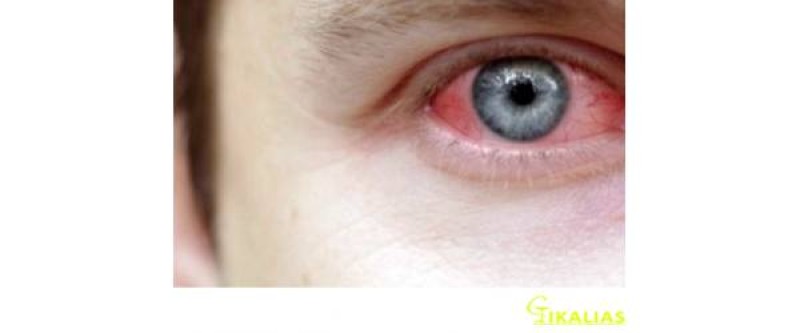Δωρεάν αποστολή για παραγγελίες άνω των 49.00€

Ραγοειδίτιδα: Η επικίνδυνη φλεγμονή στο μάτι
Η ραγοειδίτιδα είναι φλεγμονή στον ραγοειδή χιτώνα, δηλαδή στο μεσαίο από τα τρία στρώματα από τα οποία αποτελείται το μάτι.
Ο ραγοειδής χιτώνας βρίσκεται ανάμεσα στον ινώδη χιτώνα (το εξωτερικό στρώμα του ματιού) και τον αμφιβληστροειδή χιτώνα (βρίσκεται βαθιά μέσα στο μάτι).
Δεν είναι μία ενιαία δομή, αλλά αποτελείται από επιμέρους, στις οποίες συμπεριλαμβάνεται η ίριδα, δηλαδή ο έγχρωμος δακτύλιος γύρω από την κόρη του ματιού.
Όταν η φλεγμονή της ραγοειδίτιδας εντοπίζεται στην ίριδα, αποκαλείται ιρίτιδα ή πρόσθια ραγοειδίτιδα.
Συμπτώματα και αιτίες.
Τα συμπτώματα της ραγοειδίτιδας συχνά εκδηλώνονται απότομα και μπορεί να επιδεινωθούν γρήγορα. Μερικές φορές, όμως, η εκδήλωσή τους γίνεται σταδιακά, σε διάστημα πολλών ημερών ή και εβδομάδων ακόμα.
Η ραγοειδίτιδα μπορεί να εκδηλωθεί στο ένα μάτι ή και τα δύο. Στα ύποπτα συμπτώματα συμπεριλαμβάνονται κοκκίνισμα και πόνος των ματιών, ευαισθησία στο φως, θολή όραση, εμφάνιση μαύρων κηλίδων που αιωρούνται στο οπτικό πεδίο και μειωμένη όραση.
Εμφανίζεται και σε παιδιά
Η ραγοειδίτιδα συνήθως προσβάλλει ανθρώπους αναπαραγωγικής ηλικίας (20-50 ετών), αλλά μπορεί να εκδηλωθεί και σε παιδιά.
Στις μισές περίπου περιπτώσεις, η αιτία της ραγοειδίτιδας παραμένει ασαφής. Εάν καταστεί δυνατό να βρεθεί μία αιτία, συνήθως είναι τραυματισμός ή εγχείρηση στο μάτι, λοιμώξεις , κάποια αυτοάνοση πάθηση, κάποια φλεγμονώδης πάθηση ή ένας καρκίνος που προσβάλλει τα μάτια (π.χ. λέμφωμα).
Οι παθήσεις αυτές άλλοτε αυξάνουν τον κίνδυνο ραγοειδίτιδας επειδή εξασθενούν το ανοσοποιητικό (π.χ. καρκίνος) και άλλοτε επειδή αυξάνουν τον κίνδυνο συσσώρευσης φλεγμονωδών ουσιών στο μάτι (π.χ. σαρκοείδωση).
Η ραγοειδίτιδα μπορεί να είναι οξεία ή χρόνια. Η οξεία εκδηλώνεται απότομα, σε διάστημα λίγων ωρών ή ημερών.
Στη χρόνια ραγοειδίτιδα τα συμπτώματα αναπτύσσονται βαθμιαία ή διαρκούν περισσότερο από έξι εβδομάδες.
Έτσι, ένα δυνατό κτύπημα στο μάτι, ένας διεισδυτικός τραυματισμός ή το έγκαυμα από χημικά ή φωτιά μπορεί να προκαλέσει οξεία πρόσθια ραγοειδίτιδα, δηλαδή ιρίτιδα.
Την ίδια κατάληξη μπορεί να έχει ο έρπης ζωστήρας στο πρόσωπο ή η γενετική προδιάθεση για την εκδήλωση ορισμένων αυτοάνοσων παθήσεων. Τα παιδιά με ρευματοειδή αρθρίτιδα, λ.χ., μπορεί να εκδηλώσουν χρόνια ιρίτιδα.
Παράγοντες κινδύνου και επιπλοκές.
Εκτός από την γενετική προδιάθεση στην ανάπτυξη αυτοάνοσων παθήσεων, ένας άλλος ισχυρός παράγοντας κινδύνου για ραγοειδίτιδα και ιρίτιδα είναι το κάπνισμα.
Μερικά φάρμακα, εξάλλου, όπως ορισμένα αντιβιοτικά και αντιρετροϊκά (για την HIV/AIDS λοίμωξη) μπορεί να αυξάνουν τον κίνδυνο εκδηλώσεως ιρίτιδας.
Η ραγοειδίτιδα είναι σοβαρή κατάσταση διότι αν καθυστερήσει η θεραπεία μπορεί να οδηγήσει σε σοβαρές επιπλοκές που φθάνουν έως την μόνιμη απώλεια της οράσεως.
Ειδικότερα, στις πιθανές επιπλοκές της συμπεριλαμβάνονται γλαύκωμα, καταρράκτης, βλάβη στο οπτικό νεύρο, αποκόλληση του αμφιβληστροειδούς και μόνιμη απώλεια της όρασης.
Η χρόνια ιρίτιδα μπορεί επιπλέον να οδηγήσει σε παραμόρφωση της ίριδας εξαιτίας του ουλώδους ιστού που σχηματίζεται.
Μπορεί επίσης να οδηγήσει σε συσσώρευση ιζημάτων ασβεστίου στον κερατοειδή, με συνέπεια την εκφύλισή του και την μείωση της όρασης.
Τέλος, μπορεί να προκαλέσει οίδημα στον αμφιβληστροειδή χιτώνα και τη δημιουργία κύστεων στην επιφάνειά του. Οι εκδηλώσεις αυτές μπορεί να θολώσουν ή να μειώσουν την κεντρική όραση.
Διάγνωση και θεραπεία.
Ευτυχώς, οι επιπλοκές μπορούν να αποτραπούν με την έγκαιρη διάγνωση και θεραπεία. Η διάγνωση γίνεται με κλινική εξέταση, έλεγχο της οπτικής οξύτητας και αξιολόγηση του βυθού του ματιού.
Εάν τεθούν υπόνοιες για ραγοειδίτιδα, ο οφθαλμίατρος μπορεί να ζητήσει ανάλυση υγρού από το μάτι και γενικές εξετάσεις αίματος ή/και διαγνωστικές εξετάσεις, για να ελέγξει για τυχόν συστηματική νόσο.
Άν η αιτία είναι κάποιο υποκείμενο πρόβλημα υγείας, η αντιμετώπισή του θα βελτιώσει και τη φλεγμονή στο μάτι.
Ο ασθενής μπορεί επίσης να χρειασθεί αγωγή με αντιφλεγμονώδες κολλύριο, καθώς και με κολλύρια που καταπολεμούν βακτήρια ή ιούς.
Αν η ραγοειδίτιδα προσβάλλει και τα δύο μάτια, δεν ανταποκρίνεται στα κορτικοστεροειδή ή γίνει τόσο σοβαρή ώστε απειλεί την όραση, ο γιατρός μπορεί να συστήσει ανοσοκατασταλτικά φάρμακα.
Σε σπάνιες περιπτώσεις συνιστάται χειρουργική επέμβαση για να αφαιρεθεί υγρό από το μάτι ή για να τοποθετηθεί ειδική συσκευή συνεχούς χορήγησης κορτικοστεροειδών.
Η ραγοειδίτιδα που εντοπίζεται βαθιά μέσα στο μάτι θεραπεύεται με πιο αργό ρυθμό απ’ ό,τι η επιφανειακή ραγοειδίτιδα, δηλαδή η ιρίτιδα.
Αντίστοιχα, η σοβαρή φλεγμονή χρειάζεται περισσότερο καιρό για να υποχωρήσει απ’ ό,τι η μέτρια.
Το σίγουρο είναι πως έως ότου αναρρώσει πλήρως ο ασθενής, πρέπει να υποβάλλεται τακτικά σε επανέλεγχο από τον οφθαλμίατρο για να παρακολουθεί την πορεία του και την αποτελεσματικότητα της αγωγής που του έχει συστήσει.
Σημειώνεται πως όποιος έχει πάθει μία φορά ραγοειδίτιδα, διατρέχει αυξημένο κίνδυνο υποτροπής, ακόμα κι αν η αρχική θεραπεία ήταν επιτυχημένη.
Πηγή: https://www.organiclife.gr/














